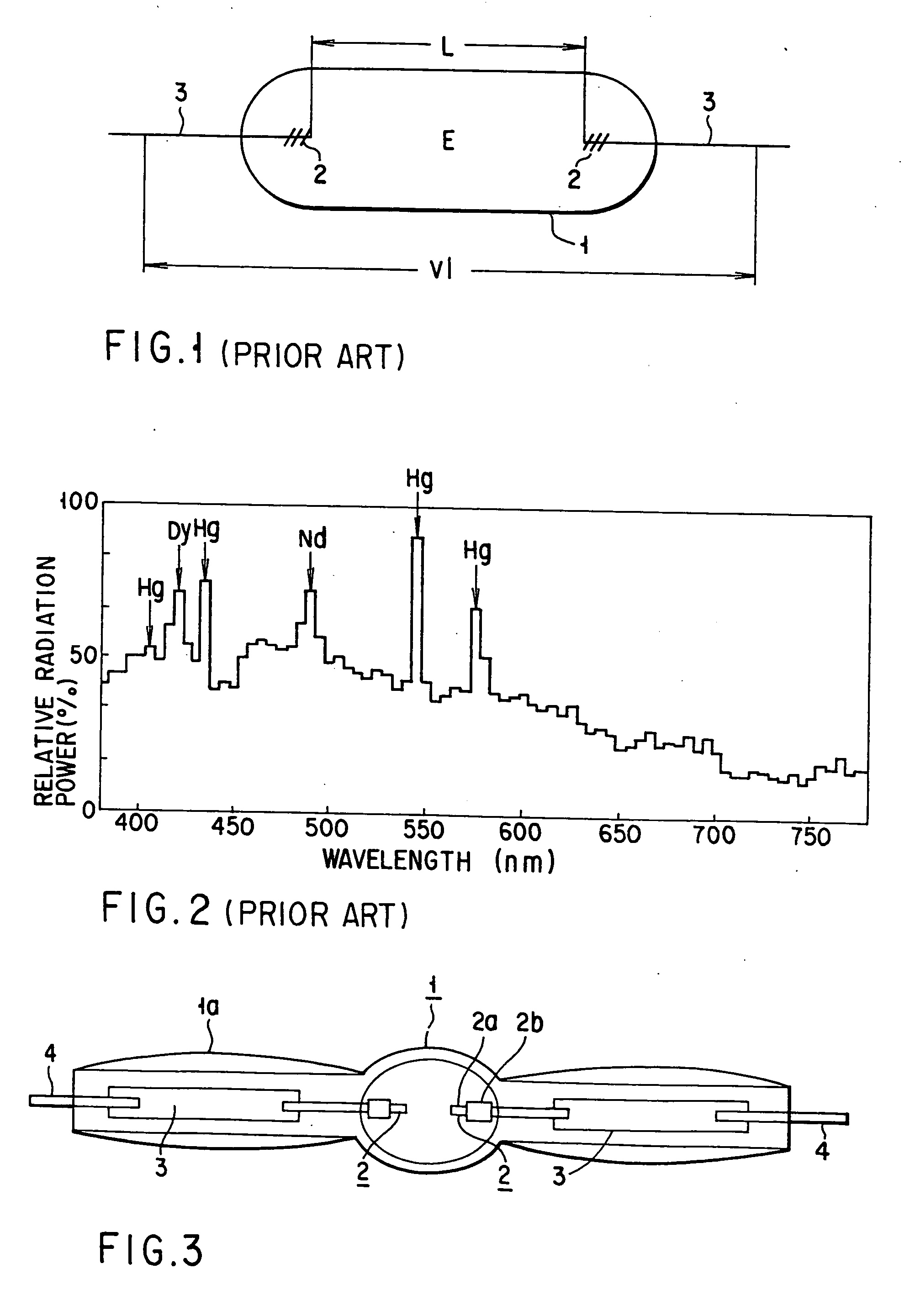Lightening device for metal halide discharge lamp
a technology of metal halide discharge and lighting device, which is applied in the direction of energy-saving lighting, transportation and packaging, lighting and heating equipment, etc., can solve the problems of low lamp efficiency, increased current capacity in the related facilities, and increased electrode loss
- Summary
- Abstract
- Description
- Claims
- Application Information
AI Technical Summary
Benefits of technology
Problems solved by technology
Method used
Image
Examples
embodiment 1
[0189]FIG. 3 is a front view showing a metal halide discharge lamp according to the first embodiment of the present invention. As shown in the drawing, the discharge lamp comprises a hermetic vessel 1, a pair of electrodes 2, metal foils 3 for the sealing, and outer lead wires 4. The metal halide discharge lamp of this embodiment is of a short arc type.
[0190] The hermetic vessel 1 is prepared by rotating under heat a quartz glass tube having an inner diameter of 14 mm into a bulb having an elliptical cross section. A pair of slender sealing portions 1a, 1a are integrally fixed to the ends in the long axis direction of the elliptical hermetic vessel 1.
[0191] The electrode 2 comprises an electrode shaft 2a and an electrode coil 2b. The tip portion of the electrode shaft 2a somewhat projects inward and, the electrode coil 2b is wound about the projecting tip portion of the electrode shaft 2a. The proximal end portion of the electrode shaft 2a is welded to one end of the sealed metal ...
embodiment 2
[0207]FIG. 7 schematically shows a liquid crystal projector as a first embodiment of the illumination apparatus of the present invention. The discharge lamp for the projector shown in FIG. 6 is used in the liquid crystal projector shown in FIG. 7. The reference numerals common with FIGS. 6 and 7 represent the same members of the projector and, thus, reference thereto is omitted in the following description.
[0208] As shown in the drawing, the liquid crystal projector comprises a liquid crystal display means 11, an image control means 12, an optical system 13, a body case 14, and a screen 15. The liquid crystal display means 11 serves to display the image to be displayed by utilizing a liquid crystal material. To be more specific, the liquid crystal display means 11 is irradiated with light emitted from behind the display means 11 by the metal halide discharge lamp 5 included in the metal halide discharge lamp apparatus and collected by the reflector 6. The image control means 12 ser...
embodiment 3
[0209]FIG. 8 is a cross sectional view, or front view, showing a metal halide discharge lamp according to a second embodiment of the present invention. The reference numerals common with FIGS. 3 and 8 denote the same members of the discharge lamp and, thus, reference thereto is omitted in the following description.
[0210] The metal halide discharge lamp of the second embodiment is also of a short arc type, and differs from the discharge lamp of the first embodiment in that, in the second embodiment, the inner volume of the hermetic vessel 1 is as small as 0.05 cc. It should also be noted that, in the second embodiment, the hermetic vessel 1 has an inner diameter of 4 mm. An electrode coil is not wound about the electrode 2. Further, the distance between the two electrodes is 4.2 mm.
[0211] The discharge medium used in the second embodiment consisted of a xenon gas sealed at 1 atmosphere, a first halide including scandium iodide (ScI3) sealed in an amount of 0.14 mg and sodium iodide...
PUM
 Login to View More
Login to View More Abstract
Description
Claims
Application Information
 Login to View More
Login to View More - R&D
- Intellectual Property
- Life Sciences
- Materials
- Tech Scout
- Unparalleled Data Quality
- Higher Quality Content
- 60% Fewer Hallucinations
Browse by: Latest US Patents, China's latest patents, Technical Efficacy Thesaurus, Application Domain, Technology Topic, Popular Technical Reports.
© 2025 PatSnap. All rights reserved.Legal|Privacy policy|Modern Slavery Act Transparency Statement|Sitemap|About US| Contact US: help@patsnap.com



